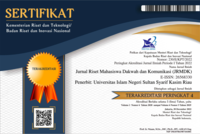HUBUNGAN SELF CONFIDENCE KONSELOR TERHADAP KEBERHASILAN KONSELING: STUDI DI BALAI REHABILITASI SOSIAL ANAK YANG MEMERLUKAN PERLINDUNGAN KHUSUS (BRSAMPK) RUMBAI DI PEKANBARU RIAU
Abstract
Keywords
Full Text:
PDFReferences
Al-Hebaish, S. M. (2012). The Correlation between General Self-Confidence and Academic Achievement in the Oral Presentation Course. Theory & Practice in Language Studies, 2(1).
Baumeister, R. F., Campbell, J. D., Krueger, J. I., & Vohs, K. D. (2003). Does high self-esteem cause better performance, interpersonal success, happiness, or healthier lifestyles? Psychological Science in the Public Interest, 4(1), 1–44.
Campbell, J. D., & Fairey, P. (1985). Effects of self-esteem, hypothetical explanations, and verbalization of expectancies on future performance. Journal of Personality and Social Psychology, 48(5), 1097.
Cheng, H., & Furnham, A. (2002). Personality, peer relations, and self-confidence as predictors of happiness and loneliness. Journal of Adolescence, 25(3), 327–340.
Donnellan, M. B., Trzesniewski, K. H., Robins, R. W., Moffitt, T. E., & Caspi, A. (2005). Low self-esteem is related to aggression, antisocial behavior, and delinquency. Psychological Science, 16(4), 328–335.
Gabriel, S., Renaud, J. M., & Tippin, B. (2007). When I think of you, I feel more confident about me: The relational self and self-confidence. Journal of Experimental Social Psychology, 43(5), 772–779.
Gawel, J. E. (1996). Herzberg’s theory of motivation and Maslow’s hierarchy of needs. Practical Assessment, Research, and Evaluation, 5(1), 11.
Hatzigeorgiadis, A., Zourbanos, N., Mpoumpaki, S., & Theodorakis, Y. (2009). Mechanisms underlying the self-talk–performance relationship: The effects of motivational self-talk on self-confidence and anxiety. Psychology of Sport and Exercise, 10(1), 186–192.
Heylighen, F. (1992). A cognitive‐systemic reconstruction of Maslow’s theory of self‐actualization. Behavioral Science, 37(1), 39–58.
Hirsch, C. R., Mathews, A., Clark, D. M., Williams, R., & Morrison, J. A. (2006). The causal role of negative imagery in social anxiety: A test in confident public speakers. Journal of Behavior Therapy and Experimental Psychiatry, 37(2), 159–170.
Kleitman, S., & Stankov, L. (2007). Self-confidence and metacognitive processes. Learning and Individual Differences, 17(2), 161–173.
Koivula, N., Hassmén, P., & Fallby, J. (2002). Self-esteem and perfectionism in elite athletes: Effects on competitive anxiety and self-confidence. Personality and Individual Differences, 32(5), 865–875.
Lazar, B. S., & Dempster, C. R. (1984). Operator variables in successful hypnotherapy. International Journal of Clinical and Experimental Hypnosis, 32(1), 28–40.
McCarty, P. A. (1986). Effects of feedback on the self-confidence of men and women. Academy of Management Journal, 29(4), 840–847.
Moore-Hayes, C. (2011). Technology integration preparedness and its influence on teacher-efficacy. Canadian Journal of Learning and Technology/La Revue Canadienne de l’apprentissage et de La Technologie, 37(3).
Pransiska, T. (2016). Konsepsi Fitrah Manusia Dalam Perspektif Islam Dan Implikasinya Dalam Pendidikan Islam Kontemporer. Jurnal Ilmiah Didaktika: Media Ilmiah Pendidikan Dan Pengajaran, 17(1), 1–17.
Rosenberg, M., Schooler, C., & Schoenbach, C. (1989). Self-esteem and adolescent problems: Modeling reciprocal effects. American Sociological Review, 1004–1018.
Saadat, M., Ghasemzadeh, A., Karami, S., & Soleimani, M. (2012). Relationship between self-esteem and locus of control in Iranian University students. Procedia-Social and Behavioral Sciences, 31, 530–535.
Sharma, M. D., & Bewes, J. (2011). Self-monitoring: Confidence, academic achievement and gender differences in physics. Journal of Learning Design, 4(3), 1–13.
Suharsimi, A. (2014). Prosodur Penelitian. (A. Suharsimi,Ed.) (ke 15). Jakarta: PT Rineka Cipta.
Vignoles, V. L., Regalia, C., Manzi, C., Golledge, J., & Scabini, E. (2006). Beyond self-esteem: influence of multiple motives on identity construction. Journal of Personality and Social Psychology, 90(2), 308.
DOI: http://dx.doi.org/10.24014/jrmdk.v3i4.13550
Refbacks
- There are currently no refbacks.
Editorial Office:
2nd Floor, Building of Da'wah and Communication Faculty, UIN Sultan Syarif Kasim Riau. Jl. HR Soebrantas Km 15, Simpangbaru, Tampan, Pekanbaru
Email : jrmdk@uin-suska.ac.id








.png)




